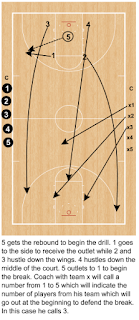When you are coaching team offense one of the most important topics that will need to be covered will be floor balance. Floor balance is making sure that your players are positioned properly to do 2 things:
- Support your teammate who has the ball in his possession.
- Force the defending team to cover as much space as possible on the defensive end.
On the surface accomplishing the 2 points mentioned above seem counter intuitive. In order to support your teammate, one needs to make sure that there are plenty of options around the ball yet when you want to force the other team to defend the whole court it implies that your players need to be spaced away from the player with the ball. Two contradicting forces fighting each other is the reason why the term floor balance is so appropriate.
Identifying the Spots
There are 5 perimeter spots on the floor.
 |
| figure 1 |
Rules for perimeter players:
- There should always be a perimeter player on the weak-side (figure 2).
 |
| figure 2 |
- Never more than 2 perimeter players on the strong side of the offense (figure 2).
- A player should always have options to pass to either side of him (figure 3) unless the ball is located on the baseline (figure 4).
 |
| figure 3 |
|
|
|
|
|
 |
| figure 4 |
Rules for Post Players:
- In general there should always be a low post option on the strong-side of the court (figure 5).
 |
| figure 5 |
|
|
|
|
|
- High post should always be prepared to support perimeter ball reversals (figure 6).
 |
| figure 6 |
- High post and low post should alternate on ball reversals (figure 7).
 |
| figure 7 |
| Now that you have been introduced to floor balance and we have put some basic rules in place you can see how a motion offense can be implemented by adding some additional instructions for cuts and screens while maintaining floor balance. We'll get into that discussion in future posts. | |










Comments
Post a Comment